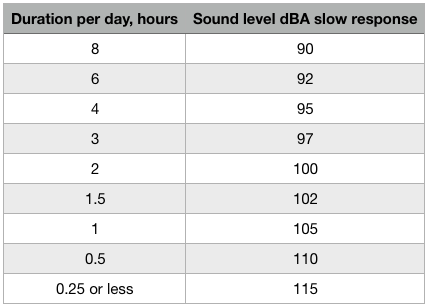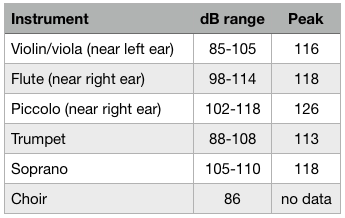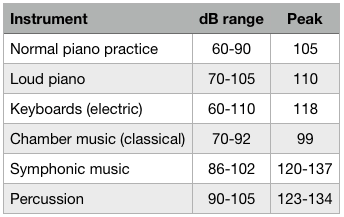If you play an instrument, and you’re not protecting your hearing, you might not hear what I hear!
Did you know that your instrument can often be louder than a subway car? Most of the time, your instrument is quite close to your ears, which increases the risk of serious hearing loss.
The Occupational Safety and Health Administration (OSHA) provides guidelines for protecting one’s hearing. Exceeding these limits can cause permanent damage. Overexposure can cause tinnitus (ringing in ears) and problems with perceived pitch.
Imagine trying to play in tune in your ensemble if hearing damage causes you to hear a Bb when everyone else around you hears an A! Of course, if overexposure continues, you will lose your hearing, and you’ll never get it back.
NOISE LEVELS
Check this out. Below you’ll see the maximum number of hours (column 1) your ears can be exposed to a certain decibel level (column 2), before permanent damage occurs. The numbers come from OSHA.

Now compare those numbers to the average decibel range of instruments you might play. If you are putting in the hours necessary to become a musical artist, you are courting disaster – and a very short-lived career (or hobby).


source: http://www.soundadvice.info/thewholestory/san12.htm
Let’s compare these numbers to some of the noise levels we’re exposed to regularly.

source: http://www.stac-uk.com/downloads/Noise%20Levels.pdf
DO YOU USE PROTECTION?
Now, back to my question at the top: Do you hear what I hear?
In spite of spending many hours each day playing my instruments in all sorts of settings, I am confident in my hearing. Why? Because I regularly have my hearing tested, and more importantly, because I always wear musician’s ear plugs to protect my hearing.
These ear plugs aren’t your average, every day, everything-sounds-like-mud ear plugs. They are actually attenuators that are custom-made to fit your ear canal, and they have filters that reduce the decibel level by different amounts.
These filters do a wonderful job of decreasing the noise level evenly across the entire range. That way, you can hear the lows and highs just as you would without the plugs, but better. Because the sound level is brought to a healthy range, the distortion that you would otherwise hear is gone, and you might find yourself actually hearing the music better than your unplugged colleagues!
I have 9 dB, 15 dB, and 25 dB filters that I can use for different situations. For solo practice time, the 9 dB are often just fine. Most ensemble playing requires the 15 dB filter. If I’m in a particularly noisy pit, the 25 dB filters come in handy. This is what mine look like:

HOW’s YOUR HEARING?
Too many people who already suffer from hearing loss have no idea they have a problem because they don’t hear what they don’t hear. Sometimes they start blaming others for not talking loud enough. Most of the time they don’t realize that the highs and lows are slowly disappearing.
Are you ready to do a quick test? It’s recommended that you listen to this using headphones. Make a note of the lowest and highest frequency you can actually hear. If you can’t hear anything above 16000 Hertz, don’t get too worried. It’s probably because YouTube’s audio compression cuts off frequencies above 16kHz.
If you want to experiment with what your ears take in on a daily basis, I recommend you get a decibel meter app. The one I use is Decibel X. Spend a little time checking out what you are doing to your ears every single day (especially when playing your instrument), and then make an appointment with an audiologist.
Any audiologist can help you get musician’s earplugs. I’m partial to the folks at Audiology Services in Nazareth, PA. They are great at what they do, and they’re just the nicest people, too! I receive nothing for endorsing them; I just happen to find them amazing.
Get on that today, so you can enjoy a lifetime full of music.
Happy Holidays!
Pamela